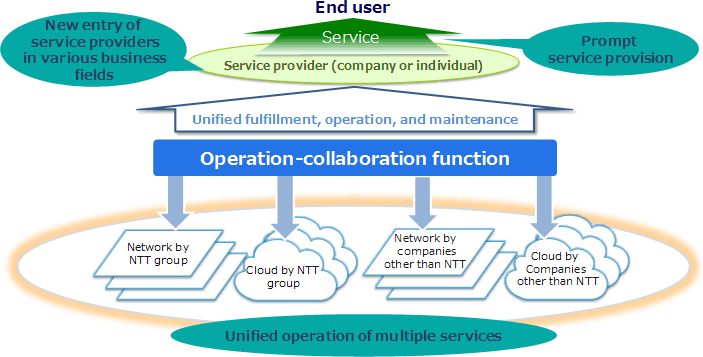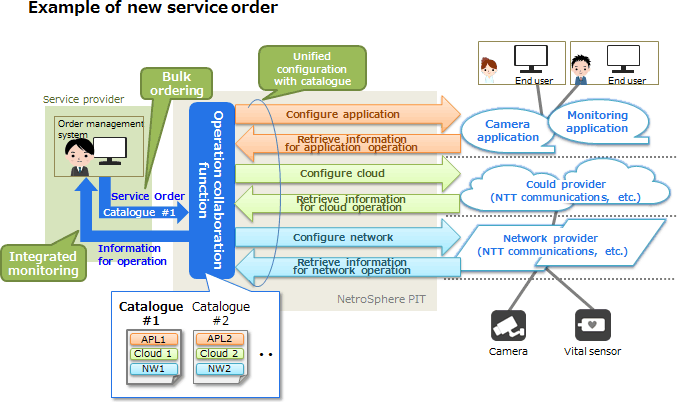Microsoft ends support for Internet Explorer on June 16, 2022.
We recommend using one of the browsers listed below.
- Microsoft Edge(Latest version)
- Mozilla Firefox(Latest version)
- Google Chrome(Latest version)
- Apple Safari(Latest version)
Please contact your browser provider for download and installation instructions.
February 1, 2017
Development of unified operation and maintenance of network, cloud, and application services by selecting the required functions defined in a catalogue to develop consolidated services. --- Establishment of operation-collaboration function via a trial usi
Nippon Telegraph and Telephone Corporation (headquartered in Chiyoda-ku, Tokyo, Japan, Hiroo Unoura, President and CEO, NTT hereinafter) has established a technology that provided unified fulfillment, operation, and maintenance of network, cloud, and application services. With this technology, service providers simply select the necessary functions defined in the catalogues. NTT verified this technology through a trial including actual commercial services that are provided by not only NTT group but also other companies.
This technology uses catalogues that define the combination of network and cloud services, which are publicly available, and integrates the operation and management of the combined services. Previously, each service provider needed a complicated service order of every network and cloud to build a consolidated service. Instead, this technology simplifies such a process, shortens the lead time for offering services, and reduces the development cost. This technology also benefits end users because they can quickly start using the new service of the service provider at low cost to them.
The collaboration function in this technology is scalable because new services can be easily added. In this technology, the APIs(*1) commonly used for cooperation are based on the specifications of the TM Forum(*2), which is an international standards body of telecommunication management. Through standardization activities, NTT aims at accelerating collaboration with many network and cloud services.
We are collaborating with NTT-group companies and other companies to promote the commercial use of this technology in the fiscal year of 2017. We aim at enhancing cooperation with more partners, i.e., not only NTT but also other companies, to facilitate more collaborated services, which will be efficiently operated and managed with this technology.
This technology corresponds to the function of MOOS(*3), which supports the operation of the B2B2X(*4) business model under the NetroSphere concept(*5). The trial is working on NetroSphere PIT(*6) by connecting public network and cloud services.
1.Background
Since the recent emergence of Internet of Things (IoT) and OTT(*7) services, such as cloud and application used in a wide variety of ways, network usage has been increasing. Service providers are required to quickly respond to market changes and promptly create new services. However, it is difficult for service providers to order every service with each cloud and application-service provider as well as to carefully manage each of these specified services.
Each service provider is currently making an effort to make the above process efficient and reduce cost. However, there is a market trend to define a common operation process. Therefore, international standardization bodies are discussing function deployment and APIs of operating the coming B2B2X.
As a result of our research and development activities for efficient operation, we developed a technology involving an operation-collaboration function.
2.Achievement
The operation-collaboration function provides a unified way of configuring and managing different services (i.e., network, cloud, and application) through cooperation among their APIs (Figure 1).

1) Operation-collaboration function
Our technology uses catalogues that describe the necessary configurations of each service (e.g. network bandwidth and design of could structure). Then, service providers only have to select the function and choose the minimal configuration defined by the catalog in advance. Thus, the service provider can integrate the management of the network, cloud, and application services. This will reduce the time to recover from a failure.
The benefit to providers of constituent network, cloud, and application services is that they can facilitate their services to be easily used by prospective/existing service providers. When the constituent providers add a new service, they will not need to develop new software but just add the lineup in the catalogue so that they can quickly provide new services.
2) APIs
The operation-collaboration function integrates various services via APIs. We developed our technology to be compliant with the TM Forum (the international standards body for digital services management).
The usability for service providers improves because service providers can use the services via such a standard API provided with this function.
From the viewpoint of network, cloud, and application providers, using a standard API increases the chance that their service will be used by more service providers in a unified standard manner. If the provider already has its own proprietary API, mediation with our technology converts it into the standard API.
Furthermore, NTT is working in the TM Forum and upstreaming a significant API that will probably be regarded as a global standard.
3) Trial
By using this technology, NTT made a contract with a partner (i.e. service provider) and began a trial using the APIs that are commercially available. In this trial, we confirmed the usability of configuration and management to combine multiple services (network, cloud, and application) offered by not only NTT group companies but also other companies. We will confirm the reduction in business flow by automating business processes and investigate the challenges to commercialization.

3.Future plans
NTT are collaborating with partners to promote the commercialization of this technology in fiscal year of 2017. We aim at improving cooperation with more partners, not only NTT but also other companies, to facilitate more collaborated services, which will be efficiently operated and managed with our technology.
We will demonstrate the one-stop order across multiple network, cloud, and application services at the NTT R&D Forum that will be held on 16-17th February 2017.(*8)
Terminology
-
API(Application Programming Interface)
This is an interface that specifies how software components should interact with each other. -
TM Forum(TeleManagement Forum)
A standardization body in the telecommunications industry that discusses/specifies the operation and management of future networks. -
MOOS(Management and Orchestration Operation System)
Under the NetroSphere concept, it controls the separated functions of a network. MOOS combines them and provides a service required by service providers. -
B2B2X model
A business model in which an infrastructure provider (e.g. telecommunication company) supports a service provider's business.
B means a company and X includes an end user, company, employee, and public office. -
NetroSphere
"NetroSphere: Towards the Transformation of Carrier Networks" - NTT news release Feb 19, 2015
http://www.ntt.co.jp/news2015/1502e/150219a.html -
NetroSphere PIT
Tesdbed for NetroSphere where various technologies are tested. -
OTT (Over The Top)
Companies (i.e. mainly other than telecommunication companies) that provide message, voice video services, etc. -
NTT R&D Forum 2017
To be held on February 16-17, 2017 at the NTT Musashino R&D Center (Musashino, Tokyo).
Information is current as of the date of issue of the individual press release.
Please be advised that information may be outdated after that point.
NTT STORY
WEB media that thinks about the future with NTT










